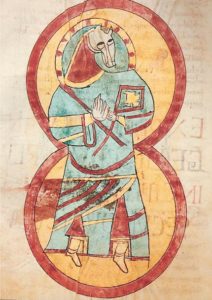Membra disiecta: un fragment des Evangiles ayant appartenu à Gilles de Roye, abbé de Royaumont
Actuellement sur ebay, vente d’une partie d’un manuscrit des Evangiles acheté par Gilles de Roye (Aegidius de Roya, 1415-1478), abbé de Royaumont (1453-1459), du libraire Jehan Guymier. Une autre partie se trouve à la Bridwell Library.
[BIBLE] 10-leaf fragment of the Gospel of John, 8:6-11:41, with Glossa Ordinaria. [France, probably Paris] c. 1210-1225
An important and continuous fragment of a glossed Gospel of John, made in the early thirteenth century:
Description 10 ff. (signed L3-12 in a modern hand), leaf dimensions 365 x 245 mm et infra, accomplished in a dense gothic liturgical hand of 50 lines (gloss) and 25 lines (Gospel text) with interlinear glosses, in a carbon or possibly high-quality iron-gall ink, justification of all text 224 x 129 mm, classical composition of three columns, foliated 122-131 in a modern hand, ruled in plummet with the scribe’s original pin-hole guides visible in head, tail, and gutter margins of each leaf, chapter headings in red, blue, and black, paragraph marks alternating red and blue, 20 two-line parti-colored initials, a diple begins each commentary, contemporary annotations in a small cursive hand in iron-gall ink, red pigment is vermilion; blue is lapis or azurite.

Bound in recent quarter calf over wooden boards, dimensions 376 x 256 mm.
Provenance
Early provenance is unsubstantiated, but Eric C. White, head of Rare Books at the Bridwell Library at SMU, which owns another fragment of the same Bible, reports.
A note on the final page [Of Bridwell’s fragment] in fifteenth-century script sheds light upon the manuscript’s provenance from the Cistercian Abbey of Royaumont in the diocese of Beauvais, France: « This book was acquired by brother Gille de Roye, Abbey of Royaumont, from Jehan Guymier, library of Paris, by exchange made with him of four books of Kings and of Luke and John, glossed, which were duplicates in the library of Royaumont. Done the month of February in the year 1458 ».
Modern provenance begins in 1839, when the rare-book collector nonpareil, Sir Thomas Phillipps, acquired from Paris bookseller E. Tross a volume of the Gospels of Luke and John (entire glossed Bibles originally ran 20 volumes or more, and full sets are unknown; Luke and John were always bound in one volume, and Matthew and Mark in another), of which our fragment was a part. While in his collection, it was catalogued as Phillipps 13805. After his death, the manuscript was sold at Sotheby’s on April 27, 1903 in Part XII of the extraordinary, decades-long Phillips Sale, Lot # 457. It was then acquired by Sir Sydney Cockerell (possibly at the aforementioned Sotheby’s sale), and then descended to his son Christopher in 1962. According to Schoenberg, in the period between 1903 and 2005, the manuscript was also sold and/or owned by Robinson’s, (1949, Catalogue # 78, Lot 21), Leighton (?), Philpot (?), and Spurgeon’s College, becoming their MS #1. Between 2003 and 2005, the John/Luke volume was fractioned and dispersed; some of the fragments, including the present, were offered at Sotheby’s in 2005, Lot no. 2, Sale L05241, Western Manuscripts and Miniatures. By early 2006, the fragment was owned by J. V. Maraglino Fine Books. I bought it from him, through eBay auction 7007327925, in mid March, 2006 for $16,484.00.
Notes
Jean Guymier, \ »escripvain\ », un des quatre grands libraires jurés de l’Université de Paris, où il exerça jusqu’en 1486. Rouse, Manuscripts and their makers, II, p. 7273.
Gilles de Roye, d’une noble famille picarde, chroniqueur et théologien. Il entra, adolescent, chez les Cisterciens, fit ses études de théologie à Paris, et professa pendant 19 ans dans diffèrents collèges. A 60 ans il se démit de ses fonctions d’abbé de Royaumont pour se retirer au couvent des Dunes (Belgique), consacrant son temps à la méditation et à l’étude. Il mourut à l’abbaye de Sparmaillé, près de Bruges, en 1478. On lui doit une chronique historique, abrégée de celle de Jean Brando (+ 1428), moine des Dunes. Elle fut poursuivie par Adrien de Budt jusqu’en 1479. On la trouve imprimée, Opus vastum Chronodromi seu chronici ab origine mundi usque ad annum 1414. auctore Joanne Brandone, S.T.D. ac religiosi Dunensis; in compendium redactum et ab anno 1431 usque ad 1479 productum ab AEgidio de Roya, dans Rerum Belgicarum annales, publié à Francfort en 1620. Cf. Kervyn de Lettenhove, Chroniques relatives à l’histoire de la Belgique sous la domination des ducs de Bourgogne. Textes latins. Chroniques de religieux des Dunes, Jean Brandon, Gilles de Roye, Adrien de But, Bruxelles, 1870.

Abbaye cistercienne de Royaumont. (c) CEE Val d’Oise.
Liens
Autre partie des Evangiles ayant appartenu à Gilles de Roye, Bridwell Library [En ligne]. Au f. 179v: « Ce livre a esté acquis par frère Gille de Roye, abbé de Royaulmont, de Jehan Guymier, libraire de Paris, par eschange fait avec luy des IIII l. des Rois et de Lucas et Johannis glosati, lesquels estoient doubles en la librairie de Royaulmont, et n’en y avoit point de pareil à ce présent. Fait le mois de février l’an Mil cccc lviij ».
La Haye, Den Haag, MMW, 10 A 21, Aegidius van Roya, Compendium historiae universalis [En ligne] Ci-dessous Gilles de Roye présentant son ouvrage:

Wikipedia [En ligne]
Biblio
Michel Huglo, La dispersion des manuscrits de Royaumont, dans Revue bénédictine, 113, 2003, p. 365-406; II. Gilles de Roye, 115, 2005, p. 205-210.
Christopher De Hamel, Medieval and Renaissance Manuscripts from the Library of Sir Sydney Cockerell, London, 1987.
Numéro sur Ebay: 330173378382
Images du manuscrit [En ligne]
Schoenberg database [En ligne]
Visite virtuelle de l’abbaye de Royaumont [En ligne]
Site de l’abbaye des Dunes [En ligne]
Horae ad usum macloviensis diocesis
Texte publié dans : Jean-Luc Deuffic, Notes de bibliologie. Livres d’heures et manuscrits du Moyen Age identifiés, dans Pecia. Le livre et l’écrit, 7, 2009 [Lien].
The Codex Gigas
The Codex Gigas or the Devil’s Bible is a medieval manuscript at the National Library in Stockholm that is famous for two features. First, it is reputed to be the biggest surviving European manuscript. Secondly, it contains a large, full page portrait of the Devil.
This site contains a digitised version of every page of the manuscript as well as commentaries on its history, texts, script, initials and decoration.
The manuscript was made in Bohemia (now part of the modern Czech Republic) between about 1200 and 1230. It is remarkable that virtually all of the manuscript, script, initials and decoration, appears to have been the work of one person who probably worked in a Benedictine monastery. The Codex Gigas contains four long texts as well as a complete Bible. The manuscript begins with the Old Testament, and it is followed by two historical works by Flavius Josephus who lived in the first century AD. These are The Antiquities and The Jewish War. ..
Manuscrit numérisé (digitised version) [En ligne]
Stockolm, National Library [En ligne]
Indiqué: blog The medieval scriptorium [En ligne]
LIBER Manuscript Librarians Group : Third International Conference
The LIBER Manuscript Librarians Group recognises the unique significance of manuscript and archive collections, not only for the world of research and learning, but also for a wider audience of people interested in history and cultural heritage…
The Third Manuscript Librarians Conference will be held at the Staatsbibliothek zu Berlin, Germany – 28-30 November 2007.
Le Manuscript Librarians Group est né en 2001 sous la tutelle de la Ligue Européenne des Bibliothèques de Recherche.
Sa troisième conférence aura lieu les 28/30 novembre 2007 à Berlin.
Site du Manuscript Librarians Group [En ligne]
Site de LIBER [En ligne]
Program [En ligne]
PAGES ANNEXES
Auteur du blog : Jean-Luc DEUFFIC




